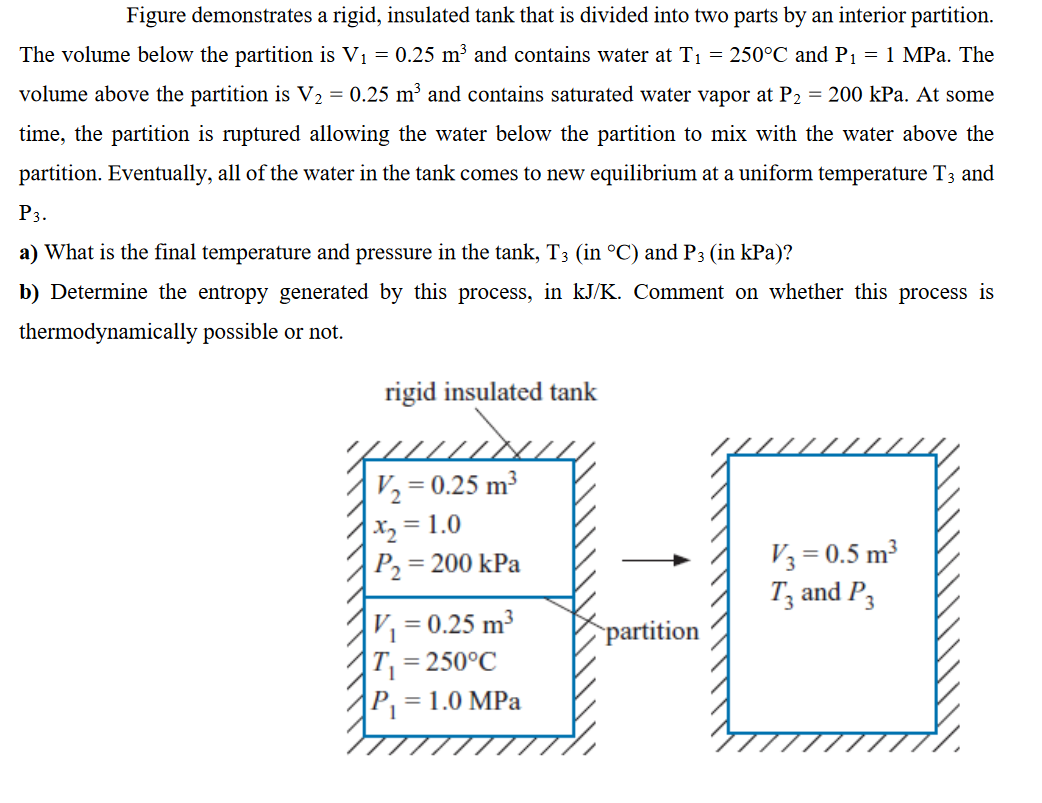Figure demonstrates a rigid, insulated tank that is divided into two parts by an interior partition. The volume below the partition is V1 = 0.25 m³ and contains water at T1 = 250°C and P1 = 1 MPa. The volume above the partition is V2 = 0.25 m³ and contains saturated water vapor at P2 = 200 kPa. At some time, the partition is ruptured allowing the water below the partition to mix with the water above the partition. Eventually, all of the water in the tank comes to new equilibrium at a uniform temperature T3 and P3. a) What is the final temperature and pressure in the tank, T3 (in °C) and P3 (in kPa)? b) Determine the entropy generated by this process, in kJ/K. Comment on whether this process is thermodynamically possible or not.
Figure demonstrates a rigid, insulated tank that is divided into two parts by an interior partition. The volume below the partition is V1 = 0.25 m³ and contains water at T1 = 250°C and P1 = 1 MPa. The volume above the partition is V2 = 0.25 m³ and contains saturated water vapor at P2 = 200 kPa. At some time, the partition is ruptured allowing the water below the partition to mix with the water above the partition. Eventually, all of the water in the tank comes to new equilibrium at a uniform temperature T3 and P3. a) What is the final temperature and pressure in the tank, T3 (in °C) and P3 (in kPa)? b) Determine the entropy generated by this process, in kJ/K. Comment on whether this process is thermodynamically possible or not.
Elements Of Electromagnetics
7th Edition
ISBN:9780190698614
Author:Sadiku, Matthew N. O.
Publisher:Sadiku, Matthew N. O.
ChapterMA: Math Assessment
Section: Chapter Questions
Problem 1.1MA
Related questions
Question

Transcribed Image Text:Figure demonstrates a rigid, insulated tank that is divided into two parts by an interior partition.
The volume below the partition is V1 = 0.25 m³ and contains water at T1 = 250°C and P1 = 1 MPa. The
volume above the partition is V2 = 0.25 m³ and contains saturated water vapor at P2 = 200 kPa. At some
time, the partition is ruptured allowing the water below the partition to mix with the water above the
partition. Eventually, all of the water in the tank comes to new equilibrium at a uniform temperature T3 and
P3.
a) What is the final temperature and pressure in the tank, T3 (in °C) and P3 (in kPa)?
b) Determine the entropy generated by this process, in kJ/K. Comment on whether this process is
thermodynamically possible or not.
Expert Solution
This question has been solved!
Explore an expertly crafted, step-by-step solution for a thorough understanding of key concepts.
This is a popular solution!
Trending now
This is a popular solution!
Step by step
Solved in 3 steps with 6 images

Knowledge Booster
Learn more about
Need a deep-dive on the concept behind this application? Look no further. Learn more about this topic, mechanical-engineering and related others by exploring similar questions and additional content below.Recommended textbooks for you

Elements Of Electromagnetics
Mechanical Engineering
ISBN:
9780190698614
Author:
Sadiku, Matthew N. O.
Publisher:
Oxford University Press

Mechanics of Materials (10th Edition)
Mechanical Engineering
ISBN:
9780134319650
Author:
Russell C. Hibbeler
Publisher:
PEARSON

Thermodynamics: An Engineering Approach
Mechanical Engineering
ISBN:
9781259822674
Author:
Yunus A. Cengel Dr., Michael A. Boles
Publisher:
McGraw-Hill Education

Elements Of Electromagnetics
Mechanical Engineering
ISBN:
9780190698614
Author:
Sadiku, Matthew N. O.
Publisher:
Oxford University Press

Mechanics of Materials (10th Edition)
Mechanical Engineering
ISBN:
9780134319650
Author:
Russell C. Hibbeler
Publisher:
PEARSON

Thermodynamics: An Engineering Approach
Mechanical Engineering
ISBN:
9781259822674
Author:
Yunus A. Cengel Dr., Michael A. Boles
Publisher:
McGraw-Hill Education

Control Systems Engineering
Mechanical Engineering
ISBN:
9781118170519
Author:
Norman S. Nise
Publisher:
WILEY

Mechanics of Materials (MindTap Course List)
Mechanical Engineering
ISBN:
9781337093347
Author:
Barry J. Goodno, James M. Gere
Publisher:
Cengage Learning

Engineering Mechanics: Statics
Mechanical Engineering
ISBN:
9781118807330
Author:
James L. Meriam, L. G. Kraige, J. N. Bolton
Publisher:
WILEY